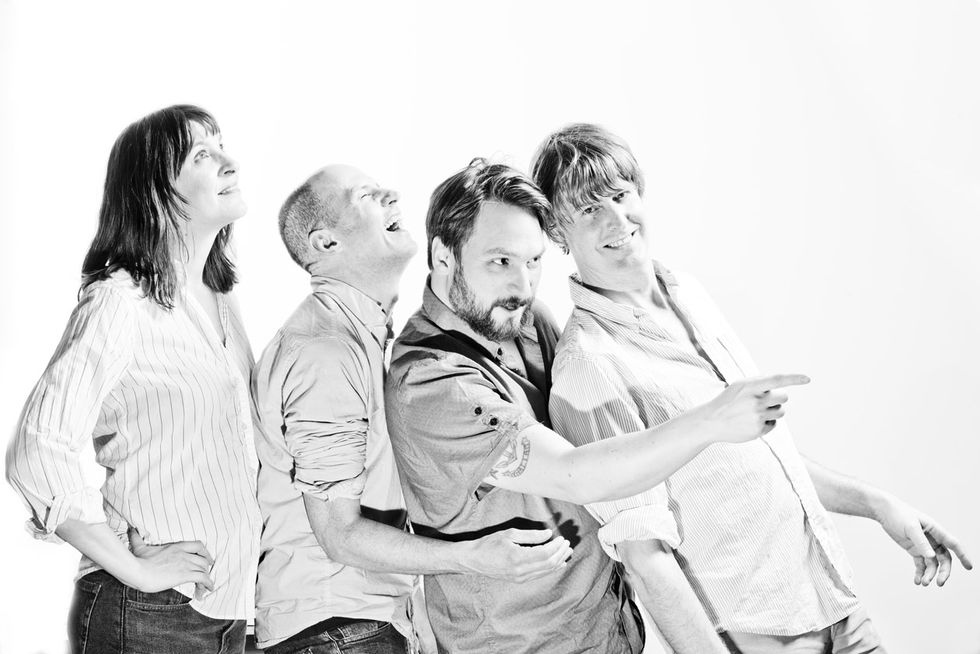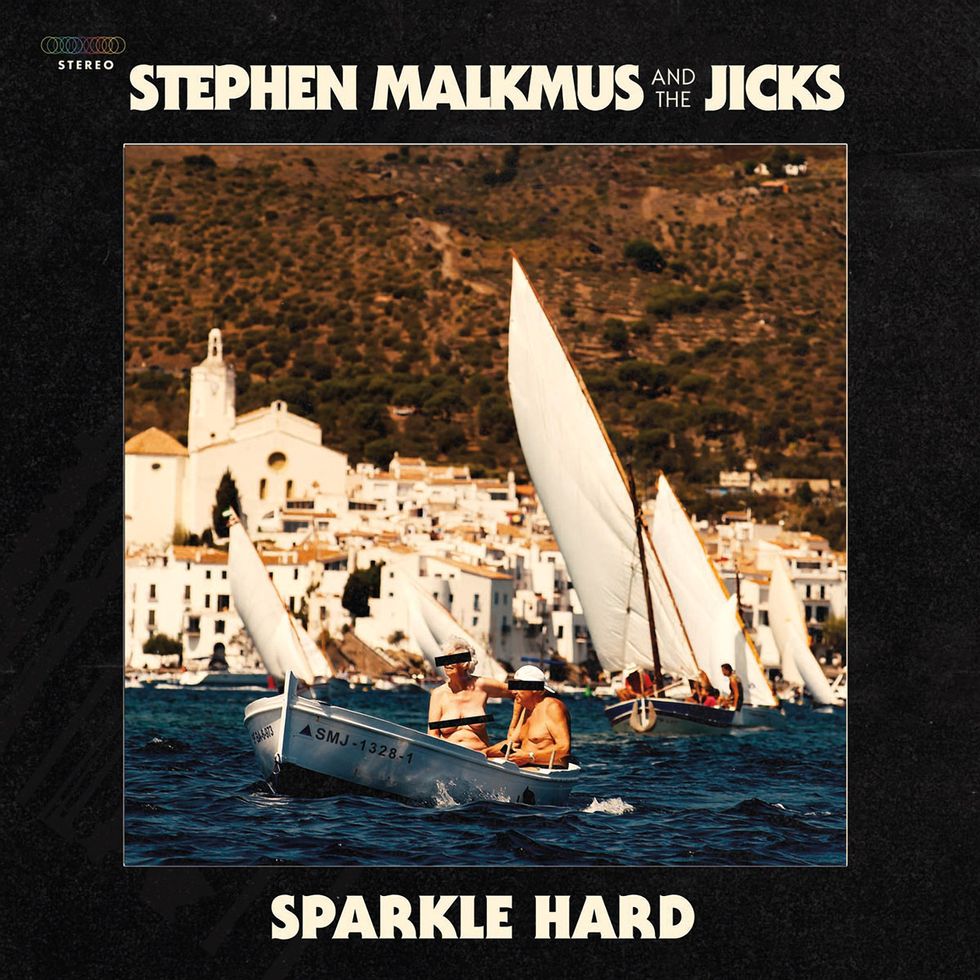
Malkmus gave his band, the Jicks, a more collaborative role this time, seeking their feedback on the multiple demos, which often explored different genres, that he brought in to record Sparkle Hard. Photo by James Rexroad
July 03, 2018 Original on Premiere Guitar.com
In the 1990s, Pavement—a band from Stockton, California, that started strictly as a recording project—emerged as one of the most critically acclaimed indie rock groups of the decade. Singer and guitarist Stephen Malkmus was central to Pavement’s trademark approach: highly literate, oblique lyrics, matched by an off-center bent to the guitar. Solos on songs like “The Hexx” and “Cut Your Hair” showed Malkmus to be not necessarily a skilled guitarist in any obvious sense, but a master of melodic economy and gestural effects, as well as a purveyor of killer, oddball tones.
Shortly after Pavement went on hiatus in 1999, Malkmus continued his concept as a solo artist with a new band, the Jicks. The group, whose most recent lineup includes co-guitarist and keyboardist Mike Clark, bassist Joanna Bolme, and drummer Jake Morris, recently released its seventh album, Sparkle Hard. The first single, “Middle America,” is clearly in the mold of Pavement, but there are plenty of rich new details throughout, like synth-y electric guitar sounds, the unexpected occasional use of Auto-Tune on Malkmus’ vocals, and a country-ish duet (“Refute”) with Kim Gordon, best known for her work with Sonic Youth.
Shortly before the release of Sparkle Hard, Malkmus called from his home in Portland, Oregon, to talk about the peculiarities of his technique (he plays without a pick), his formative years in Stockton, and the handful of trustworthy axes he has used, both with Pavement and the Jicks, in the service of his artistic songs.
Sparkle Hard sounds excellent. What guitars did you play on the album?
Electric-wise I played some I’ve had for a long time, like my Guild S-100, I think it’s called—similar to what that guy from Soundgarden [Kim Thayil] played. I can’t remember who else played one, but they were economical ’70s guitars that are actually really good.
I’m still playing my old Strat. At home, I still play my Travis Bean, and I used it on this song called “Solid Silk.” At the end of the song, I do some solos on there. They’re just plugged directly into Pro Tools, and those Travis Beans have a certain sound. It’s a little unwieldy and heavy to play live, and also mine needs to be serviced. I can handle it in the studio, but maybe not on the road. But those are cool guitars.
What year is the Strat?
It’s a ’73 or ’74. I’ve told the story before of buying it from a friend of mine, who… I don’t know where he got it, but I don’t think that it was on the up and up. But I was 16 and I wasn’t the most on-the-up-and-up person, either. Someone had put two humbucker pickups in it, and I took those out immediately. Even then I knew that was probably a bad idea. I’ve played that guitar forever. It weighs like zero pounds. It’s just a fun guitar to play, and it sounds so cool. But then again, it also needs a little bit of looking after. These old guitars can just be great, but they do need some love. They need somebody who understands what you want and also how they should sound.
“Playing bass in a punk band is kind of like paying your dues by washing dishes in a restaurant.”
I’ve noticed that you don’t play the guitar, not even the electric, with a pick.
I play with my thumb and pointer finger exclusively. That offers me a lot of control, but, of course, people can get a lot of control with their guitar picks, too. There are plenty of outrageous flatpickers. Plus, when you’re working with distortion and compression, you can get away with a lot. You don’t have to hit every note just right, at least not with what I’m going for. But, yeah, that’s something I’ve done for the last 20 years. I’ve kind of abandoned using a pick.
Speaking of distortion, you get some great and varied sounds on the album. Is that all within Pro Tools or did you use stompboxes
No, those are all pedals. [Producer] Chris [Funk, of the Decemberists], he has a shitload of pedals and he split it two ways. There’s his way, my way, and a direct sound, which hypothetically we could’ve used, but for the most part we didn’t. He had his pedals running to one amp and he had a lot more of these ones that make your guitar sound like a synthesizer. I was like, “You go for it and I’m going to do what I do over here with my standard setup.”
On my side, there’s a lot of wah-wah on there—more than I’ve ever used. And I was coming back home to this vintage Mu-Tron volume and wah-wah that I’ve had since 1996. I left it for a while because it does alter the sound, making it more trebly. I have a bunch of EarthQuaker pedals that I was able to borrow from a friend, and I bought some, too: one of the reverb pedals they have, the phaser with an octopus on it, and a fuzz. And I have also a blue Diamond J-Drive pedal. It’s a very simple distortion pedal—very useful, no fail.

TIDBIT: Malkmus played guitar in the control room during the recording of his latest album. “It’s amazing what you can hear and what you can get away with without wearing headphones,” he says.
What would you say is the ratio of his setup to yours on the album?
That’s a good question. It goes song to song. If it sounds really gnarly, it’s more likely his setup. Sometimes we would get over synth-guitar’d and we’d want to back it off. But it’s an awesome sound. He had a pedal from Japan [a Korg Miku Stomp] that makes an anime character’s voice. I didn’t use that, but I was interested in it. Pedals can be quite addictive.
Just so I understand correctly, when you were recording, were you hearing both setups at once or were you only hearing your setup?
Yeah, I was hearing both at once. I stood in the control room with the band. I wore no headphones during the whole recording, so I was just listening to the monitors, and we were trying to develop a group sound in there. And the band sat in the other room, because the drummer and the bass player, they should be together. There’d be no bleed in my vocal. And it was a small room with mirrors and windows. I could see everybody, but they were on the other side of the fence from me, so I could hear everything coming through my vocals. I didn’t have to deal with headphone mixes.
What was it like to record a rock album without cans?
It’s kind of nice to not have to wear headphones in loud rock. You can do it in acoustic music, of course. And actually the room we had was so fancy and quiet that I’ve done some acoustic in there. It’s amazing what you can hear and what you can get away with without wearing headphones.
Hearing these kind of synth sounds from Chris’ setup—did you find it made you play differently than you normally did?
Not really. When I soloed, I just did what I normally do. We went into the studio with some pretty solid demos, which maybe I’ll release some day. If you like us, they’re interesting, but they’re maybe not for the average listener.
I kind of knew what I wanted to add, and I tried to be careful with just adding stuff and building tracks, because with Pro Tools things can get out of hand. You can Frankenstein solos together and spend forever on it. I think the songs are there. They’re going to be there whether I build all these interlocking guitars or not.
RELATED ARTICLE: Stephen Malkmus & The Jicks: "Refute","Solid Silk" & Interview For "Saturday Sessions" On "CBS This Morning"
ThisSmallPlanet.com Videos: "Harness Your Hopes"/"Stairway To Heaven"/"Beginning To See The Light" and "Summer Babe" (feat Spiral Stairs):
ThisSmallPlanet.com Videos: "Harness Your Hopes"/"Stairway To Heaven"/"Beginning To See The Light" and "Summer Babe" (feat Spiral Stairs):
Stephen Malkmus & The Jicks are playing Petaluma, California on July 17, 2018 in support of their new album Sparkle Hard. All the tech bros will be drunken dancing at the San Francisco show with clueless vendors they dragged along. All the cool people are going to the Petaluma show...
No comments:
Post a Comment